In which I argue that the two-faced man Edward Mordake was really the literary creation of the 19th-century poet Charles Lotin Hildreth.
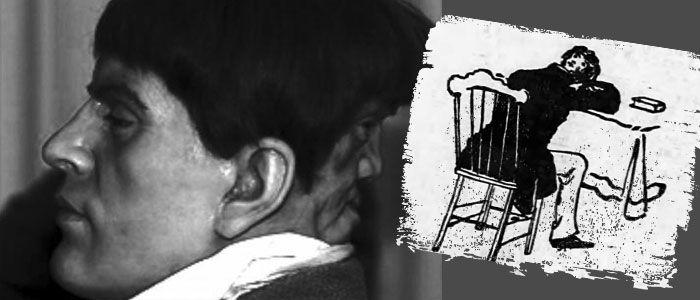
Edward Mordake (sometimes spelled Mordrake) was, so the story goes, heir to an English peerage, but this inheritance brought him no comfort because he was cursed with a terrible deformity — a second face on the back of his head. This "devil twin" possessed a kind of hateful intelligence. It never slept but instead whispered constantly of "such things as they only speak of in hell." Driven mad by this demon companion, Mordake committed suicide at the age of 23, leaving behind instructions that the demon face should be destroyed before his burial, "lest it continues its dreadful whisperings in my grave."
Many people are introduced to the story of Mordake by a photograph said to be of him that has circulated online for many years. This photo is often accompanied by a caption that briefly summarizes his unfortunate life.

However, this isn't a photograph of the actual Mordake. Instead, it's a photo of a wax replica created by an artist to show what Mordake might have looked like. Where this wax figure was displayed, or by whom it was created, I'm not sure, but various replicas of Mordake have been created over the years for wax museums around the world.
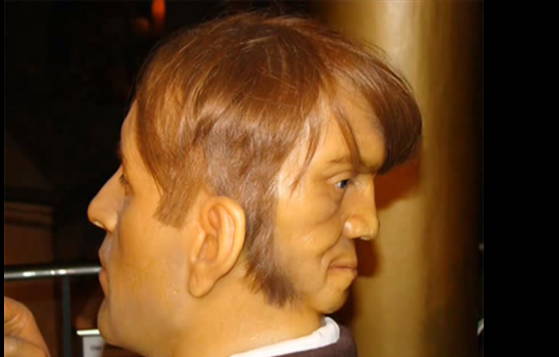
Mordake has popped up in other places in contemporary popular culture. He's the subject of a song by Tom Waits,
"Chained Together For Life." There's also an opera about him —
Mordake by Erling Wold. Recently he was featured as a character in several episodes of the TV series
American Horror Story: Freak Show. And a movie about him is reported to be
in development.
So the story of Mordake has certainly appealed to the popular imagination. But one question remains unanswered. Was Mordake a real person?
In Search of Mordake
The search for information about Mordake led researchers to an old book,
Anomalies and Curiosities of Medicine, published in October 1896. It was authored by two American doctors, George M. Gould and Walter L. Pyle, who collected together all kinds of bizarre medical cases, including the story of Mordake, which they presented as follows:
One of the weirdest as well as most melancholy stories of human deformity is that of Edward Mordake, said to have been heir to one of the noblest peerages in England. He never claimed the title, however, and committed suicide in his twenty-third year. He lived in complete seclusion, refusing the visits even of the members of his own family. He was a young man of fine attainments, a profound scholar, and a musician of rare ability. His figure was remarkable for its grace, and his face – that is to say, his natural face – was that of an Antinous. But upon the back of his head was another face, that of a beautiful girl, "lovely as a dream, hideous as a devil". The female face was a mere mask, "occupying only a small portion of the posterior part of the skull, yet exhibiting every sign of intelligence, of a malignant sort, however". It would be seen to smile and sneer while Mordake was weeping. The eyes would follow the movements of the spectator, and the lips "would gibber without ceasing". No voice was audible, but Mordake avers that he was kept from his rest at night by the hateful whispers of his "devil twin", as he called it, "which never sleeps, but talks to me forever of such things as they only speak of in Hell. No imagination can conceive the dreadful temptations it sets before me. For some unforgiven wickedness of my forefathers I am knit to this fiend – for a fiend it surely is. I beg and beseech you to crush it out of human semblance, even if I die for it." Such were the words of the hapless Mordake to Manvers and Treadwell, his physicians. In spite of careful watching, he managed to procure poison, whereof he died, leaving a letter requesting that the "demon face" might be destroyed before his burial, "lest it continues its dreadful whisperings in my grave." At his own request, he was interred in a waste place, without stone or legend to mark his grave.
Unfortunately, here the trail for clues about Mordake ran cold, because Gould and Pyle didn't reveal where they found the story. They said only that it was "taken from lay sources." And no earlier references to Mordake were known.
Nevertheless, the fact that this earliest known version of Mordake's story was in a medical text (rather than, say, a collection of short stories) added an air of authenticity to the narrative. Because although Gould and Pyle seemed willing to include in their book almost any story, no matter how questionable, their work was still non-fiction. Presumably, they didn't invent the story of Mordake. They heard about it somewhere.
Questions and Doubts
Attempts to judge the authenticity of the Mordake story by evidence internal to the tale itself proved inconclusive.
From a medical perspective, the case of Mordake could possibly be true. Or rather, not impossible. It would demonstrate the phenomenon of
craniopagus parasiticus, which, as wikipedia puts it, happens when "a parasitic twin head with an undeveloped body is attached to the head of a developed twin." Or it could be a case of
Diprosopus (also known as craniofacial duplication), which is the result of abnormal protein activity, not twinning. Either way, it's an extremely rare phenomenon, and those affected by such conditions typically don't live long past childbirth. In 2008, for instance, a young girl with two faces was born in India and survived for only six weeks.
However, while Mordake's case may not be impossible, it does include scientifically questionable details. Cases of craniopagus parasiticus, for instance, always involve monozygotic (or identical) twins, which means that the two twins are always of the same sex. Therefore, Mordake could not have had the face of a woman on the back of his head, as the story repeated by Gould and Pyle specifies. But defenders of the story could argue that this detail might be an embellishment added to the tale over the years. After all, how could anyone really determine the gender of the extra face anyway?
More serious reservations are raised by the story's general lack of sources and corroboratory details. As early as 1905, we find a report in
The Theosophical Review (December 1905) which notes that the two doctors who attended Mordake, "Manvers and Treadwell," could not be found in the
Dictionary of National Biography. Nor do their names pop up anywhere else, outside of discussions of the Mordake case.
In 1958, the folklorist Paul Brewster queried the readers of the
Journal of the History of Medicine for information about Mordake, noting that, "If this is a genuine case in
teratology, there should be authoritative sources for it." His plea went unanswered.
But these doubts and questions weren't enough to conclusively disprove the story, and popular belief in his existence was bolstered by writers in the "strange but true" genre who presented his tale to readers as fact. For instance, it was described as fact in Frank Edwards's
Strange People
(1961) as well as in the 1977 edition of
The Book of Lists
.
The Lay Source
However, I have new information that may solve the riddle of Mordake's identity, because I believe I've found the "lay source" that Gould and Pyle relied upon.
I did a keyword search of the archive of 19th-century American papers at
newspapers.com (which requires a subscription) and discovered that Mordake's story appeared in an article written by the poet Charles Lotin Hildreth that ran in American papers in 1895, approximately a year before the publication of Gould and Pyle's book. It ran first in the
Boston Sunday Post on Dec. 8, 1895, and a few days later was published in a variety of other papers, including the
Parsons Daily Sun (Dec. 11) and
The Decatur Herald (Dec. 14) .

The Boston Sunday Post - Dec 8, 1895
The article, titled
"The Wonders of Modern Science: some half human monsters once thought to be of the Devil's brood," describes a variety of remarkable "human freaks" whose cases Hildreth claims to have found in old reports of the "Royal Scientific Society" (the "musty old pages" of which, he tells us, are characterized by their "long S's and their turgid phraseology").
Among the cases Hildreth details are the "Fish Woman of Lincoln" — a young girl whose legs, from the hips downward were "covered with shining scales and terminated in the most exact tails of fish." There's a "half human, half crab" whose hands and feet end in enormous, hard-shelled claws. The "melon child of Radnor," we learn, had a head the size and color of a melon, with no perceptible organs of sense except a vertical slit for a mouth. Mr. Pewness of Stratton had feet where his hands should be, "and vice versa." The "four-eyed man of Cricklade" had two sets of eyes, one above the other. "Jackass Johnny" was cursed with "a pair of enormously long, furry ears, exactly like those of an ass." The "Norfolk spider" was a monstrous thing that crawled upon its belly with six hairy jointed legs with claws and a human head.
Illustrations that accompanied the article helped readers to visualize all these unfortunate beings.
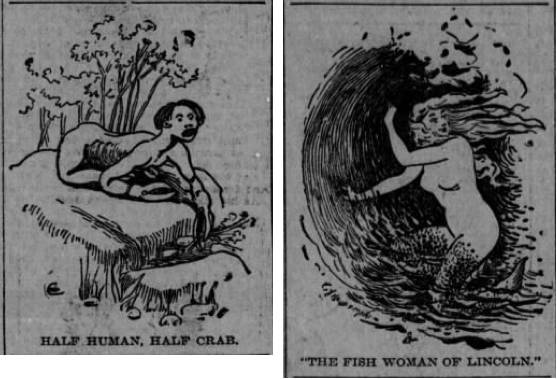
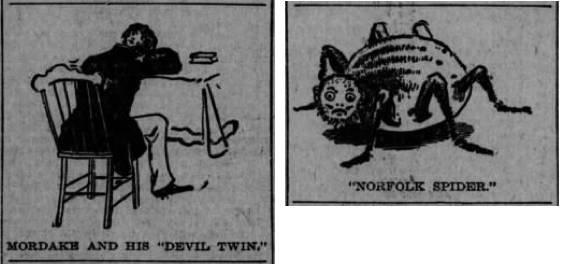
Finally the list ends with the "weirdest as well as most melancholy" story of Edward Mordake. This passage has to be Gould and Pyle's "lay source" since it is word-for-word the same as what later appears in
Anomalies.
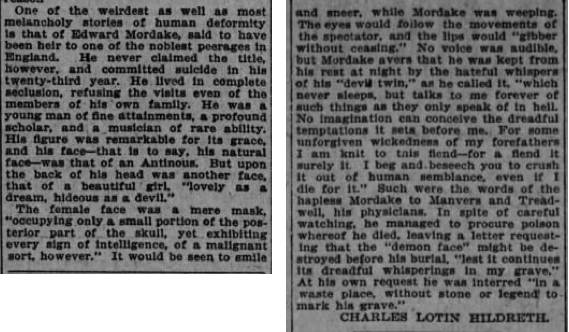
Non-Fiction or Fiction?
Hildreth's article reads like non-fiction, and it's certainly presented to readers as such. Gould and Pyle evidently thought it was a true account of old medical cases. Not only did they lift Mordake's story from it, they also took the account of the four-eyed man of Cricklade and
repeated that verbatim in their book (again, without giving Hildreth any credit).
But the more closely we examine Hildreth's article, the fishier it becomes. First of all, what is this "Royal Scientific Society" that he claims was his source? Did he mean the Royal Society of London? Perhaps he did, or perhaps he came up with a suitably impressive sounding but actually non-existent society.
And if he did mean the Royal Society of London, then it should be possible to track down earlier references to the cases he describes. After all, the early transactions of the Royal Society have all been scanned and are searchable online.
But no. These characters such as the Fish Woman of Lincoln and the Norfolk Spider are mentioned nowhere before surfacing in Hildreth's article. And when we realize this, that's when it becomes apparent that Hildreth's article was fiction. All of it sprang from his imagination, including Edward Mordake.
This makes sense because Hildreth was not only a poet, but also a writer of speculative fiction. He authored a children's novel
The Mysterious City of Oo, about a young boy's journey into the Australian outback where he discovers that "a white civilization of ancient Greek origins flourishes among the savages" (description from
The Encyclopedia of Science Fiction). His short stories frequently ran in papers, and many of them are what we would describe today as science fiction. Even
his poetry (which is very much in the tradition of Edgar Allan Poe) displays a preoccupation with gothic, other-worldly themes. So a fictional piece about "half human monsters" is something that Hildreth not only could have written, but also would have written.
It also makes sense that newspapers would have presented his story as non-fiction, because 19th-century newspapers did this frequently. It was only in the 20th Century that magazines catering specifically to speculative fiction were created and provided an outlet for writers in this genre. Before then, authors relied upon newspapers to publish their stories, and it was common to add excitement to the tales by presenting them as fact.
This tradition goes back to Poe, who published six of his tales initially in the guise of non-fiction, and the practice continued throughout the century. One of the more famous examples is the case of the
Man-Eating Tree of Madagascar. In 1874, the
New York World ran an article about this bizarre tree that ate human flesh. The piece was entirely fiction, but readers didn't know that, and for decades afterwards copies of the article continued to circulate as fact. Several explorers even went in search of the tree.
So we should add Edward Mordake to the list of 19th Century newspaper hoaxes that continued to fool people for decades (or in this case, over a century) after their publication.
In other words, Mordake never existed. He was the literary creation of Charles Lotin Hildreth.
Unfortunately, Hildreth didn't live to see the success of his creation. He died in August 1896, at the age of 39, before the publication of Gould and Pyle's
Anomalies and Curiosities of Medicine. But he doubtless would have been proud that his character has captured the imagination of so many people.




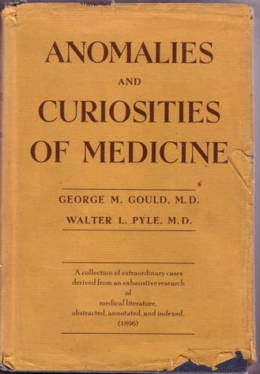




Comments
Also, I didn't know the museum was an actual, physical museum.